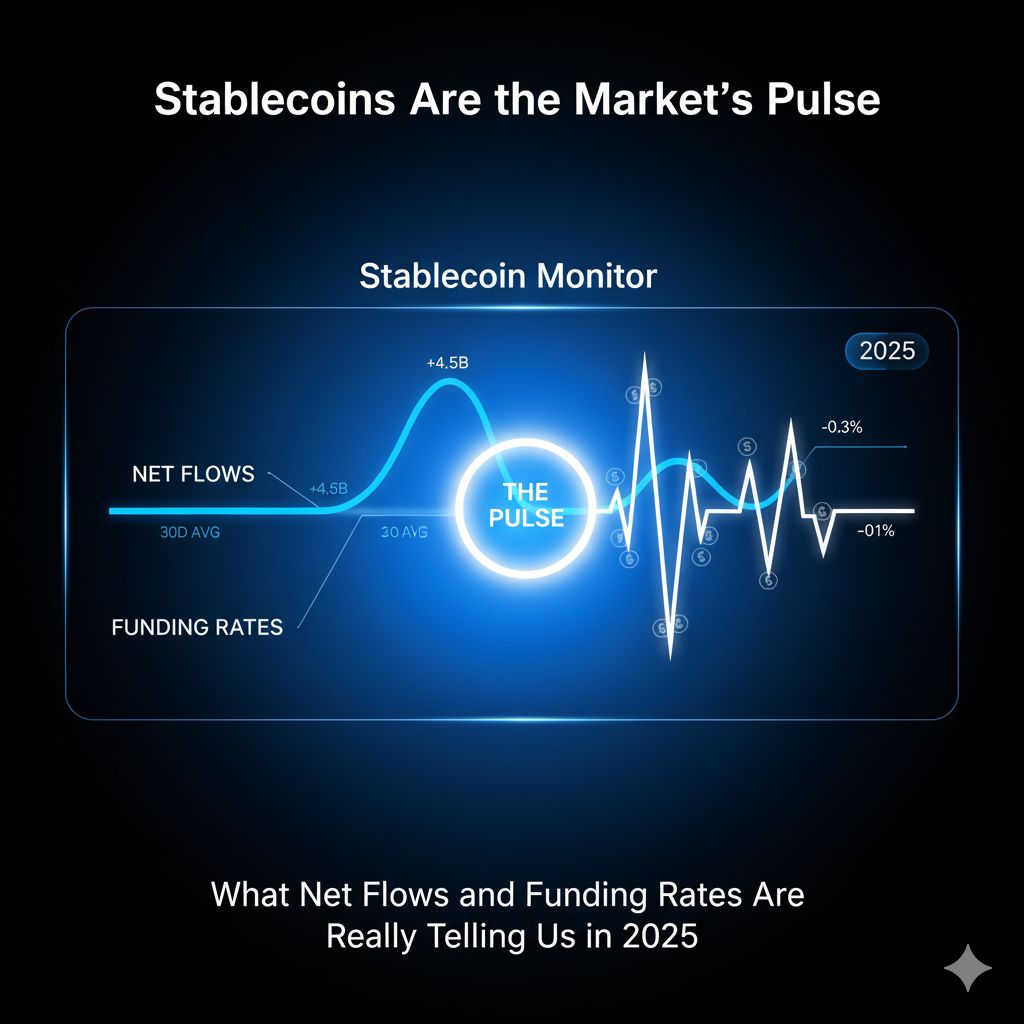
1.The Hidden Heartbeat of Crypto
Every trader keeps one eye on Bitcoin’s chart and another on Ethereum’s gas fees. But if you really want to know where crypto is heading, look at stablecoins. They may seem boring, tokens that just sit at $1, but in truth, they’re the bloodstream of the entire market. When stablecoin volumes surge, it usually signals fresh money entering exchanges. When they drain out, it’s often a sign traders are pulling risk off the table.
In 2025, with Bitcoin swinging between $110K and $120K and ETH trying to hold $5K, stablecoins have quietly become the best leading indicator of sentiment. They don’t just mirror demand; they reveal investor confidence, risk appetite, and even global capital flows.
2.Net Flows: The Inflow/Outflow That Predicts Moves
Stablecoin net flows, how much is moving into exchanges versus out, can often foreshadow price action.
- Inflow spikes: When billions of USDT or USDC flood into Binance, OKX, or MEXC, it usually means traders are gearing up to buy. Think of it as fresh gunpowder being poured into the market.
- Outflow waves: When we see the opposite — money leaving exchanges to cold wallets — it’s often a sign of caution. Traders are sidelining, maybe taking profits.
Take February 2025: $4.2B worth of stablecoins poured into exchanges in a single week ahead of Bitcoin’s rally to $116K. Analysts on X were quick to connect the dots: “Forget the ETF flows, stablecoin inflows are the real tell.”
And when net flows went negative in late March, Bitcoin stalled, and altcoins bled. It wasn’t coincidence; it was capital rotation made visible.
3.Volumes: The Size of the Game
Stablecoin trading volumes are like the sound of the crowd at a sports game. The louder it gets, the bigger the play.
2025 has seen insane activity:
- USDT’s daily trading volume has regularly topped $50B, sometimes outpacing Bitcoin itself.
- USDC, once battered by banking scares in 2023, is clawing back relevance with steady institutional adoption.
- New challengers like PYUSD (PayPal’s stablecoin) are carving niches in cross-border payments and retail settlements.
Why does volume matter? Because it tells us liquidity is alive. High volumes mean traders are rotating between assets, hedging, arbitraging, and speculating. Low volumes mean apathy, the dreaded “crab market” where nothing moves.
And right now? Volumes are roaring again. That usually precedes volatility spikes, the kind of moves traders crave.
4.Funding Rates: The Mood Ring of Leverage
If net flows are the heartbeat and volumes the voice, then funding rates are the market’s mood ring.
Funding rates are what perpetual futures traders pay (or earn) to hold their positions. When they’re:
- Positive and rising → Longs are crowding in, traders are bullish, and leverage is piling up.
- Negative → Shorts dominate, often signaling fear or hedging.
In April 2025, we saw Bitcoin’s funding rates flip sharply positive just as stablecoin inflows surged. That double signal was the clue: leverage + liquidity = liftoff. Within days, BTC spiked 12%.
But funding rates also flash danger. When they get too high, they warn of crowded trades primed for liquidation cascades. Traders who watched both stablecoin flows and funding rates side by side were able to dodge the wipeouts that liquidated billions in March.
5.How Traders Are Using This Data in 2025
Today’s sharp traders treat stablecoin analytics like weather forecasts. Here’s how:
- Pre-Positioning: Spotting inflows early helps traders front-run market rallies.
- Exit Signals: Heavy outflows often align with topping patterns, time to derisk.
- Funding + Flow Combos: If funding rates spike positive and stablecoin inflows are high, it’s a green light for short-term bullish plays, but with tight stops.
- Altcoin Hunting: Stablecoin data isn’t just about BTC. Traders track whether flows land on ETH, SOL, or newer L2 tokens. A sudden spike on MEXC’s alt pairs often precedes rotations.
Even long-term investors are watching. As one VC posted on X: “Forget sentiment surveys. Stablecoin flows are the only poll that matters.”
6.Why It Matters Beyond Trading
It’s not just degens watching the charts. Policymakers, regulators, and even traditional finance firms now track stablecoin data like hawks.
- ETF managers use net flows to gauge retail demand before adjusting allocations.
- Regulators see it as a measure of crypto’s systemic risk.
- Developers monitor volumes to spot adoption trends, especially for payment integrations.
And for exchanges like MEXC, stablecoin health is everything, it’s the oil that keeps trading engines running.
7.The Road Ahead: Stablecoins in 2025 and Beyond
Stablecoins are no longer just “digital dollars.” They’re shaping up to be the backbone of a new financial system. With PayPal, Stripe, and even banks experimenting with on-chain dollars, the flows and volumes will only grow more important.
But there are challenges:
- Regulation: The EU’s MiCA framework is live, enforcing stricter reserve rules. The U.S. is still juggling bills in Congress.
- Competition: Beyond USDT and USDC, new entrants (PYUSD, FDUSD, and Asia-based coins) are vying for dominance.
- Technology: Faster L2 settlements and AI-driven analytics will make flow tracking even sharper.
By 2030, stablecoin volumes could eclipse Visa and Mastercard combined, and the traders who learn to read their signals today will be miles ahead.
8.Wrapping Up
Stablecoins might look dull next to flashy memecoins or 100x leverage plays, but they’re the quiet giants moving markets. Net flows reveal where money’s heading. Volumes show how engaged the crowd is. Funding rates expose the market’s mood. Together, they’re the clearest lens we’ve got into crypto’s rhythm.
So next time you’re staring at BTC’s chart, do yourself a favor: check the stablecoin dashboard. It might just tell you tomorrow’s story today.
Disclaimer: This content is for educational and reference purposes only and does not constitute any investment advice. Digital asset investments carry high risk. Please evaluate carefully and assume full responsibility for your own decisions.
Join MEXC and Get up to $10,000 Bonus!
Sign Up


